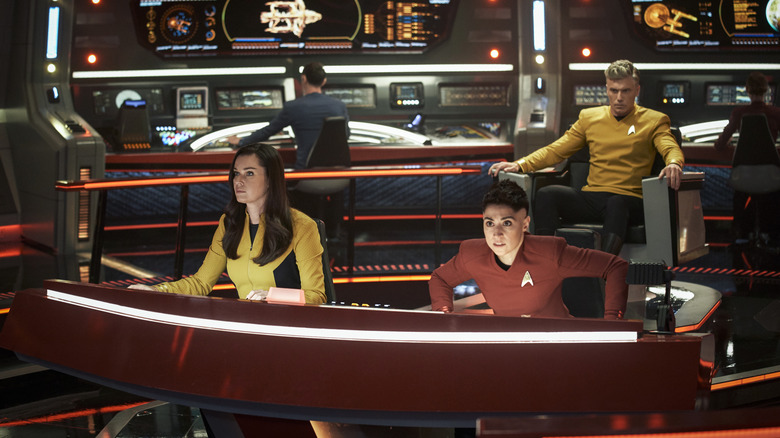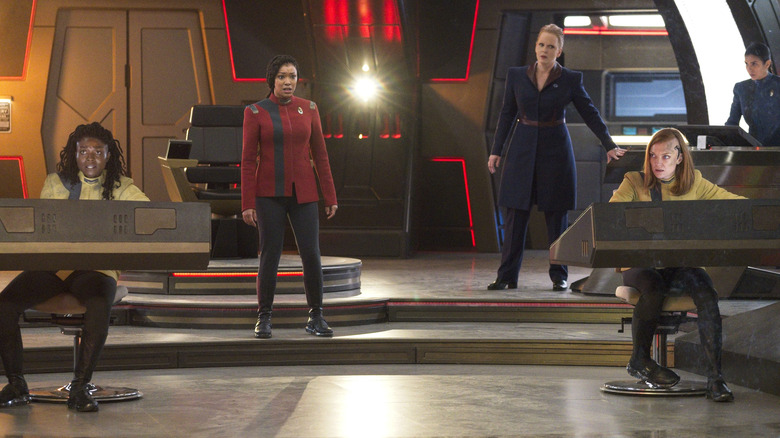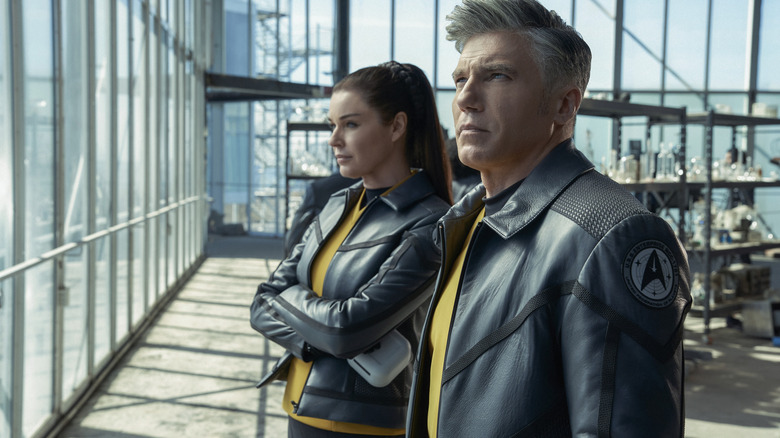Star Trek: Strange New Worlds Wraps Up Its Stories Before The Credits Roll And That Feels Amazing
Beam me out, Scotty! The following article contains spoilers for the first 3 episodes of "Strange New Worlds."
"Strange New Worlds" is far from the first installment of "Star Trek" to debut during something of a crossroads for the overall franchise. After all, when "Star Trek: The Motion Picture" instigated the leap from television to the big screen, only two years removed from the pop culture sensation known as "Star Wars" in 1977, it couldn't help but come across like an impassioned argument (or, perhaps, more like stubborn insistence) that the franchise's high-minded ideals were still relevant in a new age of pop space opera. On the other hand, the morally grey "Deep Space Nine" came around at a time when the widely celebrated "The Next Generation" series was just beginning to wind down and needed to pass the torch from the simplistic era of "The Original Series" to something more befitting of modern sensibilities. The recent trilogy of "Kelvin Timeline" films, meanwhile, injected a punk rock mentality that goes way beyond the recurring use of the Beastie Boys' "Sabotage," creating a whole new generation of fans in the process.
"Strange New Worlds," for its part, doesn't come loaded with quite as much riding on its success as many predecessors did. But even so, the first few episodes have already stood out and made this new show worth paying attention to — not just for the impressive quality of these early episodes, but for what they represent about the direction that modern "Trek" can take. Fittingly enough, this series steeped in throwback nostalgia takes its cues from "The Original Series" to posit that episodic storytelling with standalone, self-contained stories still works like gangbusters.
To this point, the first 3 episodes of this newest addition to "Trek" canon feature 3 distinct adventures with very little carryover between them. Perhaps more than anything else, wrapping up each story before the credits even roll has quickly become one of the show's greatest and most effective charms.
Lessons learned
Modern TV viewers would be forgiven for assuming that some sort of holy edict must've been handed down from the very top, requiring that stories can only be told through a highly serialized approach.
We can trace that back to the establishment of "Prestige TV" with shows like "The Sopranos," "The Wire," "Breaking Bad," and more, all of which helped normalize the idea of layering ongoing story arcs throughout entire seasons and required viewers to tune in for every single episode if they hoped to make sense of the next. Although there's nothing inherently problematic about overt serialization, at some point along the way network executives began to believe that this was the only way to maintain viewership numbers. Never mind that immensely popular juggernauts like "Buffy the Vampire Slayer" or "Lost" found a way to strike a balance between both extremes: advancing the overall plot to a certain extent with each episode, while also including various standalone entries. Not all fell under the specific definition of "bottle episodes," mind you, but all of these instances served the important purpose of taking the time to further flesh out the world-building, crucial character dynamics, and other essential moments that would likely be derided as "filler" nowadays.
Despite its traditionally episodic nature, "Star Trek" is hardly innocent of this trend. "Star Trek: Discovery" perhaps best displays the limits of this mindset. As thrilling as it is to watch Michael Burnham, Saru, and the rest of the cast overcome universe-scale threats time and again, many viewers (myself included!) couldn't help but yearn for a more low-key stretch of episodes that would've allowed a chance to spend time with the crew of the Discovery in circumstances other than a constant state of red alerts. But as a counter-example, a show like "Deep Space Nine" proved that writers clever enough to take advantage of both aspects could thrive under this happy balance. The storied Dominion War arc late in the show's run expertly weaved together some of the absolute highest highs in all of "Trek" across several episodes. But none of that would've landed if not for the crucial foundation laid down in earlier, more episodic seasons.
Just in time, "Strange New Worlds" arrived on the scene to take its cues from the best examples in years past and provide a much-needed change of pace.
Charting its own course
Unlike so many contemporaries, "Strange New Worlds" isn't interested in letting loose plot threads linger from episode to episode — and it's all the better for it.
At first, it appears as if we're in for more of the same. The premiere of "Strange New Worlds" is forced to play a quick game of catch-up, dealing with the aftermath of "Discovery" (which first introduced the fan-favorite trio of Anson Mount's Captain Christopher Pike, Ethan Peck's Spock, and Rebecca Romijn's Number One) and roping Pike back into action on the USS Enterprise. But once the housekeeping has been taken care of, the episode jumps headfirst into a brand-new story where Number One has been taken captive by an alien species stuck in a perpetual civil war — one which our heroes inadvertently exacerbated through their own actions in "Discovery." To this point, the seeds of serialization would seem to have taken root ... but only previously established characterization is maintained from this hour to subsequent ones.
Episode 2, "Children of the Comet," takes this even farther with a storyline that doubles down on its character-first priorities. We begin with an exploratory away mission that takes a small group of crewmembers onto a planetary body, where they run afoul of an impossibly advanced society. Still, as delightful as it is to watch Uhura (endearingly portrayed by Celia Rose Gooding) save the day through something as universal as music, the real highlight of the episode results from the kind of advantages that only episodic television can offer. A show that holds plot advancement above all else simply wouldn't have time to dedicate the first 10 minutes to Pike's dinner party, which does the heavy-lifting of establishing the ship's core of supporting characters and laying the track for future episodes to build upon.
Episode 3, "Ghosts of Illyria," feels like quintessential "Strange New Worlds." Noteworthy for the original backstory it gives to Number One, the episode is more interested in how this reveal causes a rift between herself and close friend La'an Noonien-Singh (Christina Chong). When the main conflict wraps up with more than 10 minutes to spare, the rest of the episode is free to deal with the lingering emotional effects on the crew.
"Strange New Worlds" isn't reinventing the wheel, but sometimes a little bit of old-fashioned, self-contained storytelling can go a long way.


